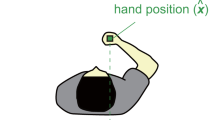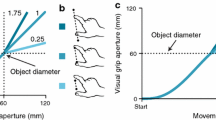Summary
Recent evidence for the use of visual cues in the programming of the precision grip has been given by Gordon et al. (1991). Visually invoked size-related information influenced the physical forces used to produce a lift, even when it was not consistent with other sensory information. In the present study, blind-folded subjects were required to feel the size of an object by haptic exploration prior to lifting it. Two boxes of equal weight and unequal size were used for the lift objects and were attached to an instrumented (grip) handle. Grip force and load force, their rates, and the vertical move ment of the object were measured. Most subjects report that the small box was heavier, which is consistent with size-weight illusion predictions. However, peak grip force, grip force rate, peak load force, and load force rate were greater for the large box when the boxes were randomly presented, but not when the same boxes were lifted consecutively. If subjects did not feel the box prior to a lift, these parameters were scaled in between those normally employed for the large and small box. Most subjects apparently programmed the parallel increase of the grip and load force during the loading phase as one force rate pulse. This represented a “target strategy” in which an internal neural representation of the objects weight determined the actual target parameter (i.e. just enough force required to overcome gravity). The other subjects exhibited a slower stepwise increase in grip and load force rate. The subjects choosing this “probing strategy” did not scale the force parameters differently for the two boxes. Furthermore, they did not perceive any difference between the objects' weight. Together, these results suggest that haptic exploration may be used to convey size information and further support the hypoth esis that size-related information may be combined with other sensory information in the programming of the precision grip.
Similar content being viewed by others
References
Brooks VB (1984) How are move and hold programs matched. In: Bloedel et al. (eds) Cerebellar functions. Springer, Berlin, pp 1–23
Claparede E (1901) Experiences sur la vitesse du soulevement des poids de volumes differents. Arch Psychol Suisse Romande 1:69–94
Cordo PJ, Flanders M (1989) Sensory control of target acquisition. TINS 15:110–117
Gachoud JP, Mounoud P, Hauert CA (1983) Motor strategies in lifting movements: a comparison of adult and child performance. J Motor Behav 15:202–216
Gordon AM, Forssberg H, Johansson RS, Westling G (1991) Visual size cues in the programming of manipulative forces during precision grip. Exp Brain Res 83:477–482
Grillner S, Rossignol S (1978) On the initiation of the swing phase of locomotion in chronic spinal cats. Brain Res 146:269–277
Hening W, Vicario D, Ghez C (1988) Trajectory control in targeted force impulses. IV. Influences of choice, prior experience, and urgency. Exp Brain Res 71:103–115
Hofsten C von, Rönnqvist L (1988) Preparation for grasping an object: a developmental study. J Exp Psychol 14:610–621
Jeannerod M (1986) The formation of finger grip during prehension: a cortically mediated visuomotor pattern. Behav Brain Res 19:305–319
Johansson RS (1990) How is grasping modified by somatosensory input? In: Humphrey DR, Freund H-J (eds) Motor control: concepts and issues. Dahlem Konferenzen. John Wiley & Sons Ltd, Chichester, pp 331–355
Johansson RS, Westling G (1984) Roles of glabrous skin receptors and sensorimotor memory in automatic control of precision grip when lifting rougher or more slippery objects. Exp Brain Res 56:550–564
Johansson RS, Westling G (1987) Signals in tactile afferents from the fingers eliciting adaptive motor responses during precision grip. Exp Brain Res 66:141–154
Johansson RS, Westling G (1988) Coordinated isometric muscle commands adequately and erroneously programmed for the weight during lifting task with precisian grip. Exp Brain Res 71:59–71
Johansson RS, Westling G (1990) Tactile afferent signals in the control of precision grip. In: Jeannerod M (ed) Attention and performance, Vol XIII. Erlbaum, Hillsdale NJ, pp 677–713
Pearson KG, Duysens J (1976) Function of segmental reflexes in the control of stepping in cockroaches and cats. In: Herman RM, Grillner S, Stein P, Stuart DG (eds) Neural control of locomotion, Vol 18. Plenum, New York, pp 519–538
Rack PMH (1981) Limitations of somatosensory feedback in control of posture and movements. In: Brooks VB (ed) Handbook of physiology: the nervous system, Vol 2. Am Physiol Soc, Bethesda MD, pp 229–256
Rice JF (1897) The size-weight illusion in the blind. Stud Yale Psychol Lab 5:81–87
Squire LR (1986) Mechanisms of memory. Science 232:1612–1619
Welford AT (1976) Skilled performance: perceptual and motor skills. Scott Foresman and Company, Glenview, Ill
Author information
Authors and Affiliations
Rights and permissions
About this article
Cite this article
Gordon, A.M., Forssberg, H., Johansson, R.S. et al. The integration of haptically acquired size information in the programming of precision grip. Exp Brain Res 83, 483–488 (1991). https://doi.org/10.1007/BF00229825
Received:
Accepted:
Issue Date:
DOI: https://doi.org/10.1007/BF00229825




